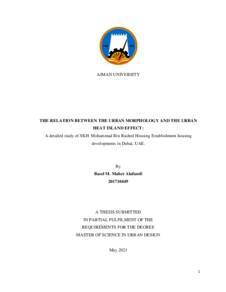وثيقة
download count
1.00
Transit Oriented Development (TOD) and Assessment of Mall of Emirates Metro Station Dubai
الناشر
Ajman University
تاريخ النشر (نص حر)
2023
اللغة
الأنجليزية
مدى
241 leaves : ill.
الموضوع
الملخص
Abstract
Transit-oriented development (TOD) is a concept that has been invented as a result of urbanization which led to the increasing number of using motor vehicles as a major commuting mode in cities. This increasing number of vehicles accelerates the urban
sprawling which eventually affected negatively people's lifestyles by increasing commuting trips distance and time, and cities infrastructure by stretching the roads which means more city funds for highways and wasting land at the expense of developing more sustainable communities and green lands.
The TOD as a strategy proved its success as an urban refinement tool throughout many developments and cities as it will show in the case studies section. TOD concept has been developed through the years along with the keep-going urban setting complexity of
modern cities. The main TOD key performance has begun with the idea of the 3Ds (Density, Diversity, and Design), afterward, researchers and planners added other 3Ds which are (Distance to transit, destination accessibility, and Demand management).
Accordingly, many researchers and planners found that the application and implementation of TOD are not one model that fits all areas, as it depends on the geographical, social, economical, political, and urban situation and characteristics of each specific city. The TOD scale can be ranging from a small scale of local development or a larger scale community to a regional scale of city-wide level.
This research assesses one of the station areas in Dubai which is the Mall of The Emirates (MOE) station area according to the TOD strategy. As the Dubai metro has emerged in an existing urban setting, and because of the increasing number of suburban
communities and the increasing number of cars which led to stretched highways with no previous urban spatial assessment done in these areas; this research assesses the spatial urban area of the MOE station according to the TOD principles and standards
based on the institute of transportation and development policy report (ITDP).
A structured methodology was conducted, starting from understanding the definitions, key components, and benefits of TOD from accredited literature and books, then choosing an official report that will be certified to act as an evaluation tool, ending by analyzing
governmental and satellite pans and images with performing a field survey.
An outcome of analyzed maps done to the MOE station area, showing illustrations of the quality, situation, and calculations of the six selected principles (Walk, Connect, Transit, Mix, Shift, Compact), As each principle has its measurement method and scoring system.
The final result of the research concluded that the area is having disparity in scores of the principles as the area lacks proper walkways and crosswalks, and it also lacks an adequate pedestrian-vehicles intersection ratio. The area also showed the block
supersizes that interfere with pedestrian seamless walkability. The analysis showed large roadways and off-street parking areas. On the other hand, the area achieved high scores in the mix of land uses, ground floor frontages, access to local services and playgrounds, and shade and shelter.
Based on the analysis result, future research can cover the remaining principles, and suggest more solutions to the existing urban problems of the area.
المجموعة
مواد أخرى لنفس الموضوع

